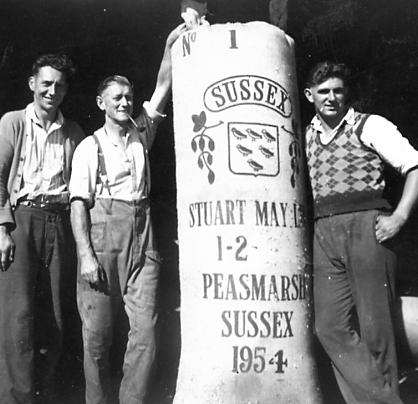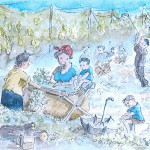by Arthur Woodgate
I have always argued that the villages of the old Rye union of parishes were once part of the Borough of Rye. When I visited the Peasmarsh Spar shop one fine morning at the beginning of September and said it was lovely ‘hopping’ weather, no one seemed to know what I was talking about I thought I had better write something about it and describe how the area was all as one during hop picking, whilst I still can, so that history does not loose it.
It must have been in 1920 or maybe a couple of years earlier when I was initiated into the seasonal ritual of hop picking. Records seem to think I was in the hop garden when I was four but it does not seem possible that one could be walking up Leasam hill early in the morning at that age, so six seems more like it.
Dragged out of bed and taken out into the cool morning air to be in the hop garden by the time picking was getting under-way was, when one looks backs, cruel. My memory of walking whilst holding mothers hand, is still very vivid. We called in on Mrs. Milton, a friend of Mothers, in Wish Street where a cup of hot drink would be waiting.
Then off we would go, Mrs Milton and us, round the old foundry (now Cyprus Place), in behind the Queen Adelaide” pub and round Tillingham Avenue to the bottom of Leasam Hill, where those of us from the West of the town were joined by those walking round Love Lane from the centre of the Town. Those from the east would have gone up Rye Hill. Anyway up we went until we reached Leasam Farm where some of us would settle and leave the rest to go down Shady Lane and across one of the few fields with no hops in them to Lea Farm. I said few fields without hops, because in those days, the Villages from Playden and Iden right up to the great hop farms of Kent, were covered in hops.
Back to Leasam, my memory tells me that Mrs. Milton, my mother and the Bailiffs wife, Mrs. Neeves were all friends and formed what was known as the “Home Set”, a set was four or five bins in a group. At that time poles were used to grow the hops up and the “Pole Pullers” who were responsible to service; maybe up to half a dozen sets; used to cut the bines at the top with a knife on a long stick, pull up the poles and place them across the bins. The measuring was done by the measure-man who; in the Leasam case, was Mr. Neeves, the Bailiff He would come round from time to time with a bushel basket, stick it in the bins and bring it up full of hops, whilst an assistant would book it down. Before my time they gave each picker a hop tally and some of these tallies are about now in Museums and such places. What ever the method of payment it was never enough for the pickers and the pushing of hops into the basket too tightly, led to there being a traditional strike each year, so putting another copper to the price per bushel.
If anyone never went into a hop garden, during picking time, in the first half of the twentieth century then they have missed something of life.
The Special Atmosphere of the Hop Fields I doubt that the annual celebrations at Bodiam each September is able to reproduce the atmosphere. When the poles were stripped of their bines, those fit for future use were stacked in such a way that they could be formed into a seat and those that were broken or were too weak for reuse were thrown out for the pickers to use as fire wood on their hop garden fires (and one did notice some pieces under the arms of the local pickers as they wearily walked home). Picture the scene if you can the smell of hops mingled with the smell of smoke from hop impregnated poles burning on the fires heating large tea kettles. At dinner time people sitting around on the beams of the bins; on the good poles; or on stools brought with them. We kids chasing each other with bits of broken poles or climbing up crab apple trees which were in the garden hedges and throwing the little sour apples at each other. Crab apples could not be eaten raw; but our mothers did wonders with them by making crab apple and blackberry jelly preserve (lovely!). The smell, sight and the sound of jabbering, topped now and then by we being shouted at to come and eat our sandwiches, and by the hop drier to keep away from the oast, is an experience unless experienced, which although I have tried; cannot adequately be described.
Cart Hangers
We must have been a menace to the drier. The teamer and the other men working in the oast and bringing in the hops, as we could hang on to the back of the cart bringing in the hops from the garden to the oast, so when they came to upload the “Pokers” (sacks with loose hops in) to “Crowd” the “Hair” (floor covered in hair mat) which the hops had to be evenly spread over to dry. We were in the way and had to be driven away like vermin. Of course if it came onto rain, we were allowed in the oast to dry off, but that led to “crowding” with people as well as hops. This didn’t happen very often, as most Septembers were reasonably dry, but there always seemed to be one really wet day, when an exodus of umbrellas would be seen walking away.
As time went on and I became a school boy we still had to go “Hopping” and school holidays were adjusted to suit. We still remained a nuisance as we played about in the hay. One thing of that period remains clear in my memory was the shriek of a rabbit being killed by a stoat.
Hooping & Mutton Legs
We had to pick some hops and a turned up umbrella was often used, but my Father made me a small bin and paid me one penny every time I filled it. When iron hoops became the fashion I wanted one of course, so I saved the pennies to buy one after hopping finished. I got 24 pennies (two shillings) but when I went to buy the hoop it was only one shilling and eleven pence (23 pennies). So I got a few sweets or a Clark’s hard bakes (sea biscuits made by Baker Clark in The Mint) as well.
Mother sent me to the Butchers to get three mutton chops, but being so engrossed with the hoop, I asked for three mutton legs. Butcher, Councillor Neeves (also in the Mint said “I know that is not what you want, so go back home, ask your mother what you do want and come back here, without the hoop, and tell me what she wants. The story of the hoop is told just to show how important hopping was to us youngsters.
Make no mistake about it, the parents were glad of this annual extra money as well. My mother used to fit me out with school clothes for the next year (no school uniform in those days). It was a day out in Hastings to get the material, rough serge from “Wards” in Queens Road. (Don’t know why she never got it from “Trueloves” in Rye High Street. Being a local trained dressmaker, she made all our clothes, including her mothers which were very elaborate.
However, the serge was made into shorts for me and although she lined them, she turned a hem up inside. Leaving me with a permanent chap just above the knees (a lovely reminder of hopping). Never did I envy the Beney boys so much as they wore long trousers almost from birth.
“Rye’s Own” December 2006
All articles, photographs, films and drawings on this web site are World Copyright Protected. No reproduction for publication without prior arrangement. (Hard Copy Back Numbers Still Available) © World Copyright 2015 Cinque Ports Magazines Rye Ltd., Guinea Hall Lodge Sellindge TN25 6EG

